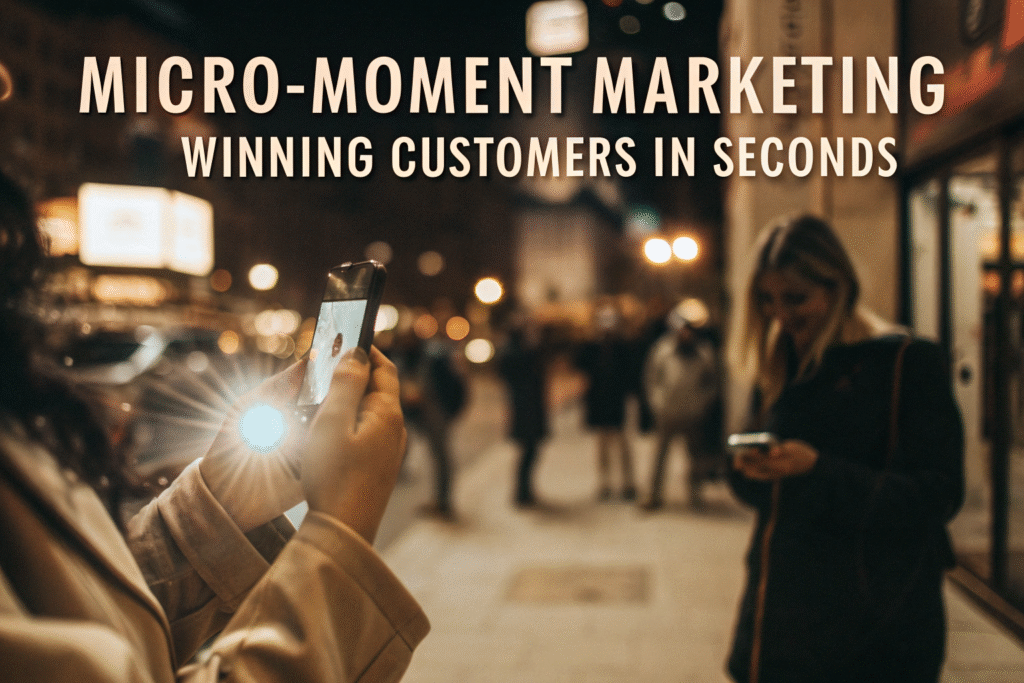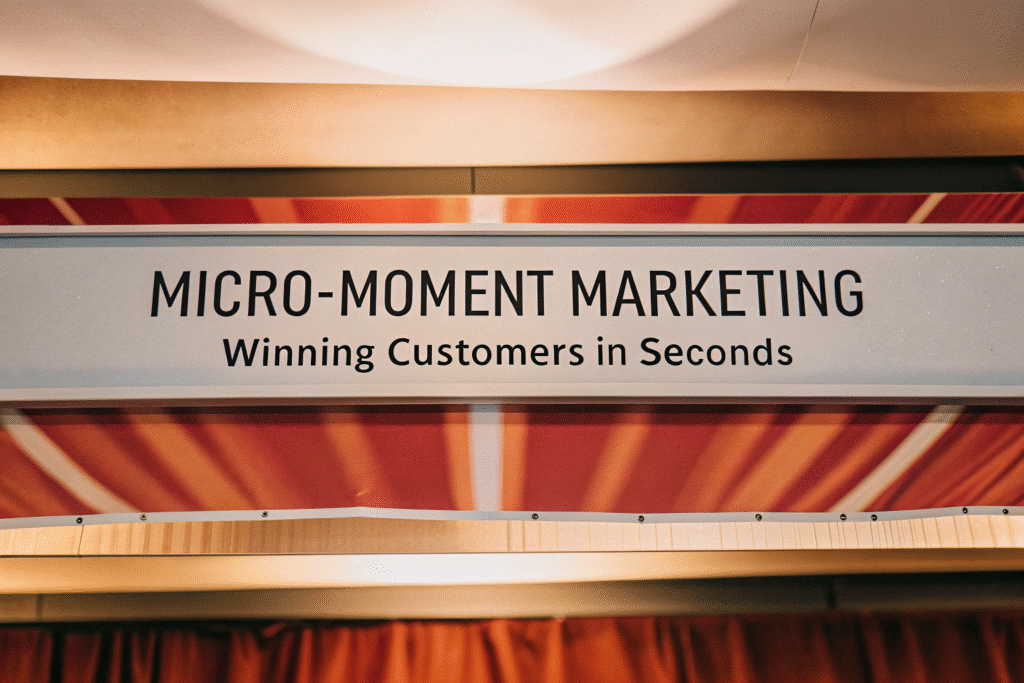
Micro-Moment Marketing is all about capturing those instant decisions people make online. Picture this: you’re standing in a store aisle, phone in hand, searching “best wireless headphones under $100.” Within seconds, you’ve made a choice based on what you see. That’s a micro-moment — and if your business isn’t visible during these crucial seconds, you’re losing customers before they even know you exist.
In today’s fast-paced digital world, consumers make snap decisions in hundreds of tiny moments throughout their day. These split-second interactions determine which brands win their business and which get left behind. Understanding and mastering micro-moment marketing isn’t just a nice-to-have skill anymore—it’s essential for survival in the digital marketplace.
This guide will walk you through everything you need to know about capitalizing on these fleeting opportunities to turn casual browsers into loyal customers.
Table of Contents
- Introduction
- History & Evolution
- Audience & Demographics
- Key Features & Functions
- Business & Marketing Potential
- Best Practices & Tips
- Challenges & Limitations
- Future Outlook
- Conclusion
History & Evolution
The Birth of a Concept
Google first introduced the term “micro-moment” in 2015, recognizing a fundamental shift in consumer behavior. As smartphones became extensions of our bodies, people stopped waiting to make decisions. Instead, they turned to their devices for immediate answers.
Before this shift, customer journeys were more linear and predictable. People would research products over days or weeks before making purchases. Now, those same decisions happen in seconds while standing in line at coffee shops or sitting on couches.
The Mobile Revolution
The evolution of micro-moment marketing mirrors the smartphone adoption curve. As mobile devices became more powerful and internet speeds increased, consumers gained the ability to act on their impulses instantly. By 2020, mobile searches had completely transformed how businesses needed to think about their digital presence.
Today, micro-moments aren’t just about mobile anymore. They’ve expanded to include voice searches, smart home devices, and even augmented reality experiences. The principle remains the same: be there when your customer needs you, with exactly what they’re looking for.
Audience & Demographics
Who Lives in Micro-Moments?
While everyone experiences micro-moments, certain demographics lean into them more heavily:
Millennials and Gen Z lead the pack, having grown up with instant information at their fingertips. These digital natives expect immediate answers and have little patience for slow-loading websites or irrelevant content.
Busy professionals between 25-45 make up another significant segment. They’re juggling work, family, and personal lives, relying on micro-moments to make quick decisions about everything from dinner plans to software purchases.
Parents represent a particularly valuable micro-moment audience. Whether they’re comparing prices on baby products or finding the nearest urgent care facility, they need fast, reliable information when their kids need something.
However, here’s the truth: micro-moments affect everyone. From teenagers deciding which game to download to retirees looking up medication information, we’re all making split-second decisions based on mobile searches.
Key Features & Functions
The Four Types of Micro-Moments
Understanding micro-moment marketing means recognizing the four distinct types:
I-Want-to-Know Moments
These are exploration phases where users are researching but not necessarily ready to buy. Someone might search “how does cryptocurrency work” or “best practices for email marketing.”
I-Want-to-Go Moments
These involve local searches with immediate intent. “Coffee shop near me” or “plumber open now” signal that someone needs something right away in their physical location.
I-Want-to-Do Moments
Users seeking help with tasks fall into this category. Think “how to fix a leaky faucet” or “recipe for gluten-free brownies.” These moments present opportunities for brands to position themselves as helpful experts.
I-Want-to-Buy Moments
The holy grail of micro-moments—users are ready to make a purchase decision. Searches like “iPhone 15 best price” or “buy running shoes size 10” indicate high commercial intent.
What Makes Them Work
Micro-moments succeed because they align with three fundamental user needs: immediacy, relevance, and context. Users expect instant results that directly address their specific situation at that exact moment.
Business & Marketing Potential
Why This Matters for Your Business
The statistics are compelling. According to industry research, 96% of smartphone users have searched for information on their phones while in the middle of a task. More importantly, 51% of smartphone users have discovered a new company or product while searching on their phones.
For E-commerce Businesses
Micro-moments directly impact your bottom line. When someone searches for product comparisons or reviews, being visible with the right information can capture sales that would otherwise go to competitors.
For Service Providers
Local service businesses thrive on “I-Want-to-Go” moments. A plumber who dominates local search results during emergency moments can build an entire business on micro-moment optimization.
For Content Creators
Bloggers and content marketers can position themselves as go-to resources by creating content that answers specific questions people ask during micro-moments.
For Digital Marketers
Understanding micro-moments helps you create better campaigns, improve ad targeting, and deliver content that actually converts.
Best Practices & Tips
How to Win Micro-Moments
Optimize for Mobile Speed
Your website must load in under three seconds. Every additional second costs you potential customers. Use tools like Google PageSpeed Insights to identify and fix slowdowns.
Create Micro-Content
Develop bite-sized content pieces that answer specific questions quickly. Think FAQ pages, how-to videos under two minutes, and concise product descriptions.
Leverage Local SEO
Claim your Google Business Profile, maintain accurate business information across directories, and encourage customer reviews. Local visibility is crucial for location-based micro-moments.
Use Long-Tail Keywords
Target specific phrases people actually search for during micro-moments. Instead of “shoes,” optimize for “best running shoes for flat feet under $150.”
Implement Schema Markup
Help search engines understand your content by adding structured data. This increases your chances of appearing in featured snippets and rich results.
Be Present Across Channels
Don’t rely solely on organic search. Use paid ads, social media, and remarketing to catch customers during various micro-moments throughout their day.
Anticipate User Intent
Study your analytics to understand what questions your audience asks. Create content that addresses these questions before users even know they need the answers.
Challenges & Limitations
The Reality Check
Micro-moment marketing isn’t without its difficulties. Competition for these brief windows of attention is fierce. Major brands with bigger budgets often dominate the most valuable micro-moments.
The Speed Challenge
Keeping up with constantly changing search algorithms and user behavior requires ongoing investment in technology and optimization.
Privacy Concerns
As targeting becomes more sophisticated, privacy regulations like GDPR and CCPA limit how businesses can track and respond to micro-moments.
Attribution Complexity
Measuring the ROI of micro-moment marketing is tricky. Users often interact with your brand across multiple micro-moments before converting, making it difficult to track which touchpoints matter most.
Content Volume Demands
To be present in all relevant micro-moments, you need extensive content libraries. This requires significant resources for creation, maintenance, and optimization.
Future Outlook
What’s Next for Micro-Moments
The future of micro-moment marketing is evolving rapidly. Voice search is creating audio-first micro-moments where traditional SEO tactics don’t always apply. Users asking Alexa or Siri questions expect different answer formats than text-based searches.
Artificial intelligence is making micro-moment targeting more precise. AI can predict when users are likely to experience specific micro-moments and serve relevant content proactively.
Augmented reality is creating visual micro-moments. Imagine pointing your phone at a product and instantly seeing reviews, pricing, and purchase options overlaid on your screen.
The rise of zero-click searches means brands must work harder to capture attention even when users find answers directly in search results without clicking through to websites.

Conclusion: Seize the Moment
Micro-moment marketing represents a fundamental shift in how businesses connect with customers. These brief seconds of intent-driven searching are where purchasing decisions happen, brand loyalty forms, and market leaders emerge.
The brands that win aren’t necessarily the biggest or oldest—they’re the ones that show up when it matters most with exactly what customers need. Start by understanding your audience’s micro-moments, optimize your digital presence for speed and relevance, and create content that serves immediate needs.
Your competitors are already competing for these moments. The question isn’t whether you’ll embrace micro-moment marketing—it’s whether you’ll do it before you get left behind.
Ready to get started? Audit your mobile experience today. Search for your own business on your phone. Are you finding what you need within seconds? If not, you know where to begin.
The next micro-moment is happening right now. Make sure your business is there to capture it.